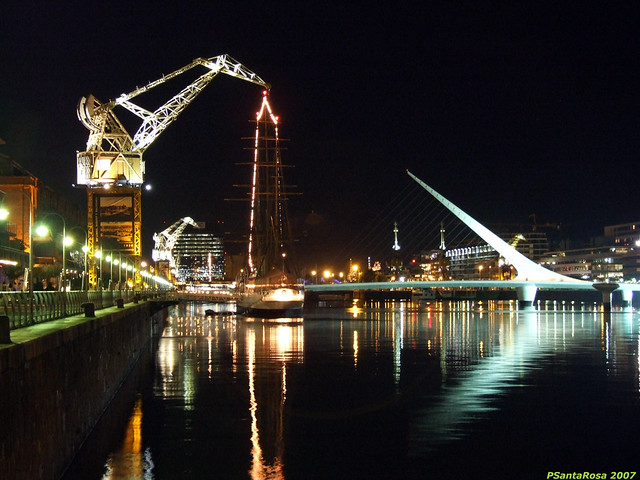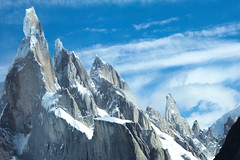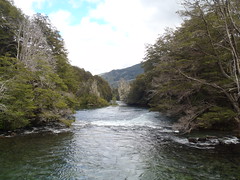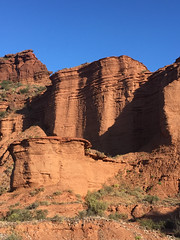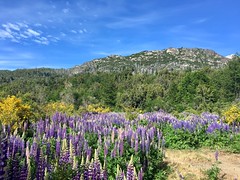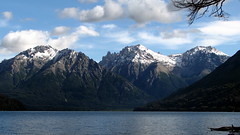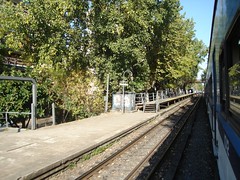 Argentina
Argentina
Argentina (Spanish: [aɾxenˈtina]), officially the Argentine Republic (Spanish: República Argentina), is a country in the southern half of South America. Argentina covers an area of , making it the second-largest country in South America after Brazil, the fourth-largest country in the Americas, and the eighth-largest country in the world. It shares the bulk of the Southern Cone with Chile to the west, and is also bordered by Bolivia and Paraguay to the north, Brazil to the northeast, Uruguay and the South Atlantic Ocean to the east, and the Drake Passage to the south. Argentina is a federal state subdivided into twenty-three provinces, and one autonomous city, which is the federal capital and largest city of the nation, Buenos Aires. The provinces and the capital have their own constitutions, but exist under a federal system. Argentina claims sovereignty over the Falkland Islands, South Georgia and the South Sandwich Islands, and a part of Antarctica.
The earliest recorded human presence in modern-day Argentina dates back to the Paleolithic period. The Inca Empire expanded to the northwest of the country in Pre-Columbian times. The country has its roots in Spanish colonization of the region during the 16th century. Argentina rose as the successor state of the Viceroyalty of the Río de la Plata, a Spanish overseas viceroyalty founded in 1776. The declaration and fight for independence (1810–1818) was followed by an extended civil war that lasted until 1861, culminating in the country's reorganization as a federation. The country thereafter enjoyed relative peace and stability, with several waves of European immigration, mainly Italians and Spaniards, radically reshaping its cultural and demographic outlook; over 60% of the population has full or partial Italian ancestry, and Argentine culture has significant connections to Italian culture.
The almost-unparalleled increase in prosperity led to Argentina becoming the seventh-wealthiest nation in the world by the early 20th century. In 1896, Argentina's GDP per capita surpassed that of the United States and was consistently in the top ten before at least 1920. Currently, it is ranked 62nd in the world. Following the Great Depression in the 1930s, Argentina descended into political instability and economic decline that pushed it back into underdevelopment, although it remained among the fifteen richest countries for several decades. Following the death of President Juan Perón in 1974, his widow and vice president, Isabel Perón, ascended to the presidency, before being overthrown in 1976. The following military junta, which was supported by the United States, persecuted and murdered thousands of political critics, activists, and leftists in the Dirty War, a period of state terrorism and civil unrest that lasted until the election of Raúl Alfonsín as president in 1983.
Argentina is a regional power, and retains its historic status as a middle power in international affairs. A major non-NATO ally of the United States, Argentina is a developing country that ranks 47th in the Human Development Index, the second-highest in Latin America after Chile. It maintains the second-largest economy in South America, and is a member of G-15 and G20. Argentina is also a founding member of the United Nations, World Bank, World Trade Organization, Mercosur, Community of Latin American and Caribbean States and the Organization of Ibero-American States.
Etymology
The description of the region by the word Argentina has been found on a Venetian map in 1536.
In English, the name "Argentina" comes from the Spanish language; however, the naming itself is not Spanish, but Italian. Argentina (masculine argentino) means in Italian "(made) of silver, silver coloured", derived from the Latin "argentum" for silver. In Italian, the adjective or the proper noun is often used in an autonomous way as a substantive and replaces it and it is said l'Argentina.
The name Argentina was probably first given by the Venetian and Genoese navigators, such as Giovanni Caboto. In Spanish and Portuguese, the words for "silver" are respectively plata and prata and "(made) of silver" is plateado and prateado. Argentina was first associated with the silver mountains legend, widespread among the first European explorers of the La Plata Basin.
The first written use of the name in Spanish can be traced to La Argentina, a 1602 poem by Martín del Barco Centenera describing the region. Although "Argentina" was already in common usage by the 18th century, the country was formally named "Viceroyalty of the Río de la Plata" by the Spanish Empire, and "United Provinces of the Río de la Plata" after independence.
The 1826 constitution included the first use of the name "Argentine Republic" in legal documents. The name "Argentine Confederation" was also commonly used and was formalized in the Argentine Constitution of 1853. In 1860 a presidential decree settled the country's name as "Argentine Republic", and that year's constitutional amendment ruled all the names since 1810 as legally valid.
In English, the country was traditionally called "the Argentine", mimicking the typical Spanish usage la Argentina and perhaps resulting from a mistaken shortening of the fuller name 'Argentine Republic'. 'The Argentine' fell out of fashion during the mid-to-late 20th century, and now the country is referred to as "Argentina".
History
Pre-Columbian era
The earliest traces of human life in the area now known as Argentina are dated from the Paleolithic period, with further traces in the Mesolithic and Neolithic. Until the period of European colonization, Argentina was relatively sparsely populated by a wide number of diverse cultures with different social organizations, which can be divided into three main groups.
The first group are basic hunters and food gatherers without development of pottery, such as the Selknam and Yaghan in the extreme south. The second group are advanced hunters and food gatherers which include the Puelche, Querandí and Serranos in the centre-east; and the Tehuelche in the south—all of them conquered by the Mapuche spreading from Chile—and the Kom and Wichi in the north. The last group are farmers with pottery, like the Charrúa, Minuane and Guaraní in the northeast, with slash and burn semisedentary existence; the advanced Diaguita sedentary trading culture in the northwest, which was conquered by the Inca Empire around 1480; the Toconoté and Hênîa and Kâmîare in the country's centre, and the Huarpe in the centre-west, a culture that raised llama cattle and was strongly influenced by the Incas.
Colonial era
Europeans first arrived in the region with the 1502 voyage of Amerigo Vespucci. The Spanish navigators Juan Díaz de Solís and Sebastian Cabot visited the territory that is now Argentina in 1516 and 1526, respectively. In 1536 Pedro de Mendoza founded the small settlement of Buenos Aires, which was abandoned in 1541.
Further colonization efforts came from Paraguay—establishing the Governorate of the Río de la Plata—Peru and Chile. Francisco de Aguirre founded Santiago del Estero in 1553. Londres was founded in 1558; Mendoza, in 1561; San Juan, in 1562; San Miguel de Tucumán, in 1565. Juan de Garay founded Santa Fe in 1573 and the same year Jerónimo Luis de Cabrera set up Córdoba. Garay went further south to re-found Buenos Aires in 1580. San Luis was established in 1596.
The Spanish Empire subordinated the economic potential of the Argentine territory to the immediate wealth of the silver and gold mines in Bolivia and Peru, and as such it became part of the Viceroyalty of Peru until the creation of the Viceroyalty of the Río de la Plata in 1776 with Buenos Aires as its capital.
Buenos Aires repelled two ill-fated British invasions in 1806 and 1807. The ideas of the Age of Enlightenment and the example of the first Atlantic Revolutions generated criticism of the absolutist monarchy that ruled the country. As in the rest of Spanish America, the overthrow of Ferdinand VII during the Peninsular War created great concern.
Independence and civil wars
Beginning a process from which Argentina was to emerge as successor state to the Viceroyalty, the 1810 May Revolution replaced the viceroy Baltasar Hidalgo de Cisneros with the First Junta, a new government in Buenos Aires composed by locals. In the first clashes of the Independence War the Junta crushed a royalist counter-revolution in Córdoba, but failed to overcome those of the Banda Oriental, Upper Peru and Paraguay, which later became independent states. The French-Argentine Hippolyte Bouchard then brought his fleet to wage war against Spain overseas and attacked Spanish California, Spanish Chile, Spanish Peru and Spanish Philippines. He secured the allegiance of escaped Filipinos in San Blas who defected from the Spanish to join the Argentine navy, due to common Argentine and Philippine grievances against Spanish colonization. At a later date, the Argentine Sun of May was adopted as a symbol by the Filipinos in the Philippine Revolution against Spain. He also secured the diplomatic recognition of Argentina from King Kamehameha I of the Kingdom of Hawaii. Historian Pacho O'Donnell affirms that Hawaii was the first state that recognized Argentina's independence.
Revolutionaries split into two antagonist groups: the Centralists and the Federalists—a move that would define Argentina's first decades of independence. The Assembly of the Year XIII appointed Gervasio Antonio de Posadas as Argentina's first Supreme Director.
On 9 July 1816, the Congress of Tucumán formalized the Declaration of Independence, which is now celebrated as Independence Day, a national holiday. One year later General Martín Miguel de Güemes stopped royalists on the north, and General José de San Martín took an army across the Andes and secured the independence of Chile; then he led the fight to the Spanish stronghold of Lima and proclaimed the independence of Peru. In 1819 Buenos Aires enacted a centralist constitution that w…
Looking for places related to Argentina?
Those are other destinations to find places related to Argentina:
